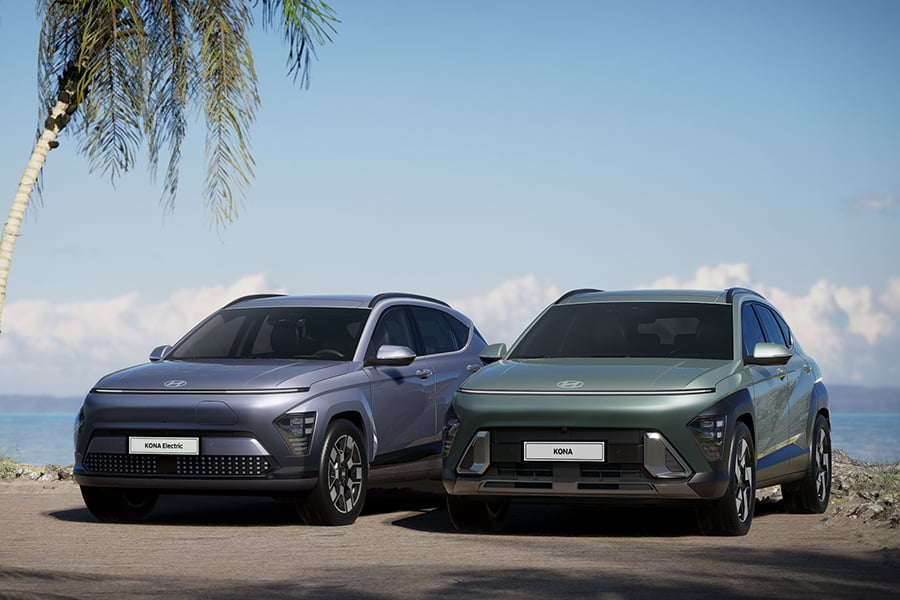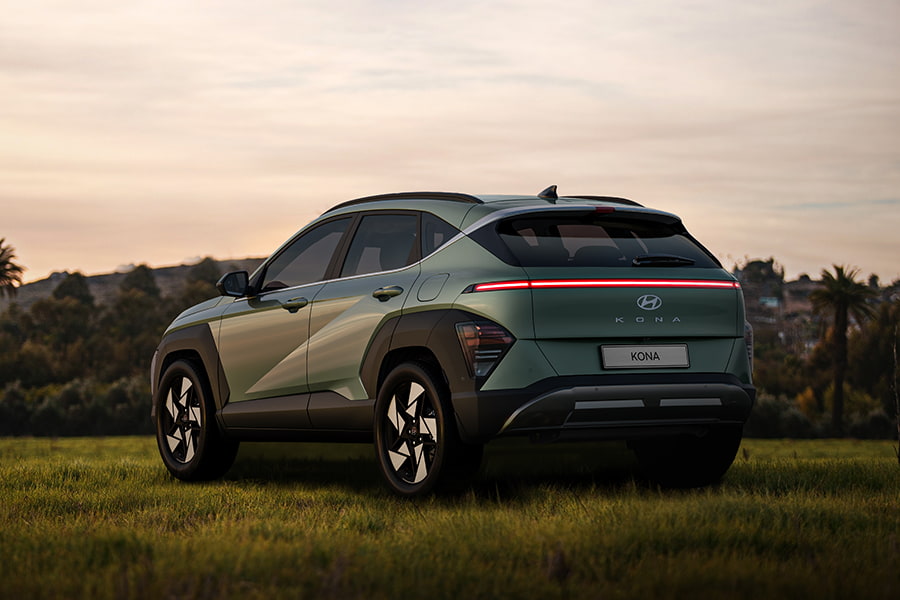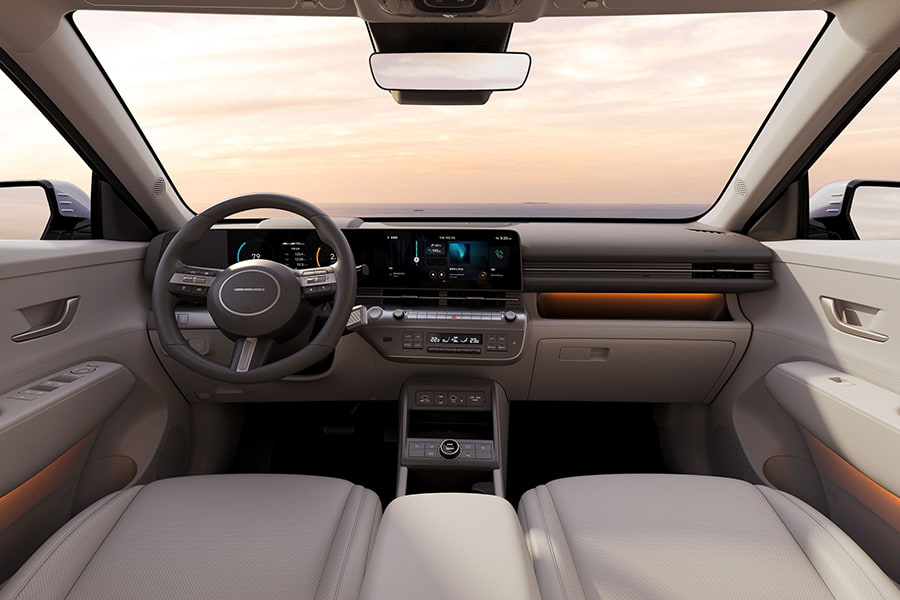Whether you’re ready to get started or would like to know more, we’re here to help.
By Carsales staff
Hyundai has promised the sequel to its blockbuster Kona small SUV will be more dramatic than the original with a storyline that focuses harder on saving the planet.
The bold, new 2023 Hyundai Kona will be offered with a choice of internal combustion, electric and (for the first time) hybrid powertrains.
The standard petrol models (including sporty N Line versions) are due to arrive in Australia first by the middle of the year followed by the Hybrid and Electric variants around November.

The second-generation Kona brandishes a striking new visual identity epitomised by the brand’s ‘seamless horizon’ headlights and taillights that comprise striking full-width LED light bars.
Physically larger and better equipped than before, the new-generation small SUV is almost certainly set to be more expensive than the current model, which is priced between $26,900 and $64,000, plus on-road costs – the latter for the extended range Kona EV Highlander.
The entry-level Kona variants will continue with the same 2.0-litre petrol engine (110kW/180Nm) as the current model while sporty N Line models are powered by a 1.6-litre turbo-petrol four (146kW/265Nm). Both engines are said to receive a series of ‘mild tweaks’ to improve drivability.
The all-new Hybrid models feature a “specially calibrated” version of the 1.6-litre petrol engine paired with an electric motor to deliver a combined output of 104kW of power and up to 265Nm of torque.
More details of the updated Kona Electric’s battery and electric motor will be revealed next month (March), although it is expected to share vital statistics with the Kia Niro EV which uses the same fundamental underpinnings and pumps out 150kW and 375Nm with a driving range of around 460km.
As a signpost to the intersection of electric mobility, the Korean car maker claims it started with the exterior design of the Kona Electric and worked backwards through the hybrid and petrol models when evolving the all-new small SUV’s design – not the other way round, as is customary – which has resulted in a radical new look for the Kona.

Along with the space age ‘seamless horizon’ LED headlights and taillights, the rear-end of the 2023 Hyundai Kona EV will also get IONIQ 5-inspired 3D pixel LED taillights, adding a bit more razzle dazzle.
The 2023 Kona’s overall silhouette is similar to its predecessor, but the details make it look like a completely new car, with each model given an individual visual identity through uniquely redesigned front and rear bumpers and alloy wheel designs.
Base models feature accentuated wheel-arch cladding to gives them a more contemporary vibe, while sporty N Line and Electric variants feature the same area in body colour.
The Kona N Line also includes a more aggressive aesthetic with silver side skirts and twin exhaust outlets, while the Kona Electric has a smoother appearance designed to improved aerodynamics for greater driving range.
In terms of size, the new Kona has grown by 150mm in length to 4355mm long, with an extra 60mm of length between the axles, creating more interior room and up to 723 litres of boot space (SAE).

Inside the cabin, the transformation is just as bold but with a more minimalist approach, highlighted by a pair of large 12.3-inch high-resolution digital screens fitted to top-spec model grades and featuring a new operating system that allows over-the-air (OTA) software updates.
“This allows car owners to save on cost and have their cars maintained with the latest software, providing an upgradable experience,” says Hyundai, adding that things like ambient lighting will be supported by OTA updates for maintenance and new features.
New optional power-operated relaxation comfort seats have been optimised for weightless body pressure distribution “to help alleviate fatigue during long-haul driving”, says the car maker.
Other features include several charging ports for devices including a wireless charge pad and a digital key that employs near-field communication (NFC), allowing smartphones or smart watches to unlock, start and lock the vehicle.
A powered tailgate will be offered, complete with adjustable opening speed and height settings, while a comprehensive safety suite should give rivals such as the Mazda CX-30 something to think about.
Blind-spot collision avoidance assist with blind-spot view monitor, safe exit warning, high-beam assist and adaptive navigation-based cruise control with intelligent speed-limit assistance are all standard, as is active lane keeping assistance, lane following assist and highway driving assist.
Parking will be made easier with a range of helpful systems including 360-degree surround-view cameras, rear cross-traffic collision-avoidance assist (RCCA), front, side and rear parking sensors, and a remote-controlled smart parking assist function.
The Hyundai Kona was the Asian car maker’s third best-selling model (behind the i30 small car and Tucson mid-size SUV) in Australia last year, and the nation’s fourth most popular small SUV after the MG ZS, Mazda CX-30 and Mitsubishi ASX.
Complete Australian details, including final specifications and prices, will be revealed ahead of the Kona’s arrival next month.
Disclaimer: Images supplied by Hyundai.
This article was prepared by an independent author. The information contained in this article represents the views and opinions of the original author, and is based on research carried out by the original author. The appearance of the article on Maxxia's website does not constitute an endorsement of its content by Maxxia in any way. The article has been made available for informational purposes only and should not be taken as advice. While all reasonable care has been taken to ensure that the statements made by the original author in the article are fair and accurate, Maxxia does not guarantee or warrant the accuracy or completeness of this information and will not be liable for, or in connection with, any loss or damage suffered as a result of any inaccuracies, errors or omissions or your reliance on this information. You should independently research and verify information before making any decision in respect of a vehicle.


